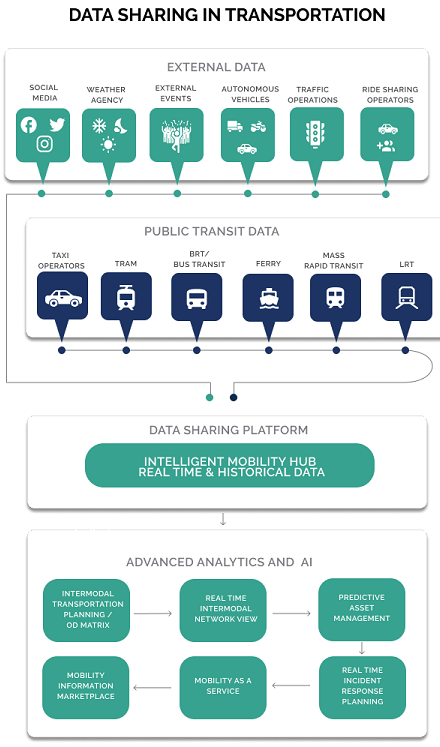Vinod Bijlani, AI and IoT practice leader at Hewlett Packard Enterprise in Singapore, looks at why real-time data sharing is critical to building efficient public transportation systems of the future
Imagine a city where the buses, rapid transit systems, coaches, trams and taxis all work together to provide reliable, predictable and accessible information that helps commuters move from point A to B safely, quickly and efficiently. Unfortunately, the reality is that today’s crowded cities face frequent traffic congestion, growing concerns around reliability, environmental impacts and energy consumption, and integration issues between transport systems.
To achieve faster and better ways to get commuters to their final destinations, the ability to share data across all modes is essential. Currently, the majority of cities share data between the different modes of transportation on a quarterly or yearly basis, mainly for the long-term planning of transportation services and infrastructure. Today, the advent of artificial intelligence (AI), big data technologies and hyper computing platforms have given multimodal data-sharing a shot in the arm to go real-time.
Multimodal data sharing is also vital not just for transport operators and governments, but also for the commuter who can access mode-specific real-time information via apps and websites. In turn, commuter data shared through location-based services by different data points can lead to the creation of new relationship models and partnerships that facilitate the sharing of data to improve efficiency in offering transport services by both the private and the public sectors.
This data from multiple transportation systems can be analysed by advanced analytics and AI techniques to improve transit services. The below figure shows a high level view of how this Real-time multimodal data, along with the democratization of AI, is unlocking opportunities in public transportation which have never been possible in the past.

Here are some real-time data sharing initiatives that cities have undertaken:
Data sharing for transport network improvements
While the Hong Kong MTR is one of the most reliable rapid transit networks in the world, a major incident in the network in 2017 highlighted the need to have real-time data sharing. As a result, the Transport Department (TD) and MTR reached an agreement for open real-time arrival data on four of its rail lines. HK MTR and other transport agencies have come together to develop a proof of concept called Exchange Square Public Transport Interchange (ESPTI) which is the first multi-party data-sharing agreement in Hong Kong designed to improve the operational efficiency and public convenience of the ESPTI.
Since then, transportation agencies in Hong Kong have conducted a use case workshop where they have identified that sharing of intermodal transport data will improve demand forecasting as well operator efficiency and passenger services.

Data sharing enables efficient incident management
One of the most innovative and successful implementations of real-time data sharing is Singapore’s Fusion AnalyticS for public Transport Emergency Response (FASTER) project. FASTER uses real time data from transit operators, buses, taxis and cellular networks as well as data from other non-traditional data sources like station wi-fi networks, video, and weather data to improve their incident response. This system implements advanced data fusion models to reconstruct the overall transportation network and how commuters are interacting with the network in real time. This provides fine-grained situational awareness and real-time decision support which helps to manage commuter flows, and to detect and respond to potential train incidents as soon as they arise. For example, insights into a potential train delay allows them to mitigate the situation by changing the direction of escalators, or calling in additional shuttle buses.
Without a system like this, it is extremely difficult for transit operations teams to predict how long an incident will last and the impact of the incident. FASTER removes this uncertainty but implements simulations on real-time data and provides responses which are optimised for reducing crowd levels and commuter delay.

The addition of other sources of real-time data from different transport modes allows FASTER to combine all this data to respond to traffic situations by taking steps like adjusting traffic light timings and provide traffic light priority to buses.
Data sharing as key to enable Mobility-as-a-Service (MaaS)
Mobility-as-a-Service (MaaS) – which describes a shift away from personally-owned modes of transportation and towards mobility provided as a service by combining transportation services from public and private transportation providers – holds the potential to change the future of transportation by providing more personalised transportation services.
Urban authorities can use commuter subscription information from MaaS to improve their routes and capacity. This could potentially provide cost savings by improving the public transport system and reduce the dependence on car ownership. In addition, it could reduce delays and congestion by increasing mobility and the options available for travellers. The shared and open data in the MaaS ecosystem would support integrated, efficient and sustainable transport systems. The growth of the service would represent an evolution in the provision of transport services.
The Whim mobile app is a successful implementation of MaaS operating in Helsinki. It offers a range of subscription and pay-as-you-go plans allowing city travellers to book and pay for buses, trains, taxis, bikes, rental cars, and more — all from a single app.

The impact of real time data sharing in Singapore, Hong Kong and Helsinki is a testament to its importance. Data is like the blood which beats through the veins of a smart transportation systems and by sharing this data, it energises and can help transportation agencies transform their operations and increase their agility.
Data will become more important as autonomous vehicles start getting deployed in public transportation. In my view, various players in the transport industry including the governments and the various public and private mobility companies, should collaborate to come up with a platform that enables them to share data. This Intelligent Transit Data hub platform would enable innovative, effective and efficient management of transit incidents and long-term planning of transit. This platform would provide a much needed agility to the transport operations and become the starting point for MaaS. A platform like this would have to be regulated, managed and governed by the transportation agencies.
As technology continues to develop day by day, the possibilities of improving the transport sector continue to broaden as well. Therefore, it is through collaboration that the benefits of technology and data analytics can be manifested in improved commuting experience, more efficient modes of public transportation and better quality of life for the residents.
Author: Vinod Bijlani is a thought leader in Data Science, Artificial Intelligence and Internet-of-Things. He is currently leading the AI and IoT Practice at Hewlett Packard Enterprise in Singapore. He has contributed to the design and implementation of Smart City projects, and established intelligent public transportation and traffic ecosystems in India, Singapore and US. Vinod is a distinguished inventor with multiple patents in advanced technologies. He envisions a radically safer, healthier and more sustainable planet with the advent of Industry 4.0, AI and IoT. For more details on Vinod’s professional background, please refer to his LinkedIn profile page
First published at CDO Trends





